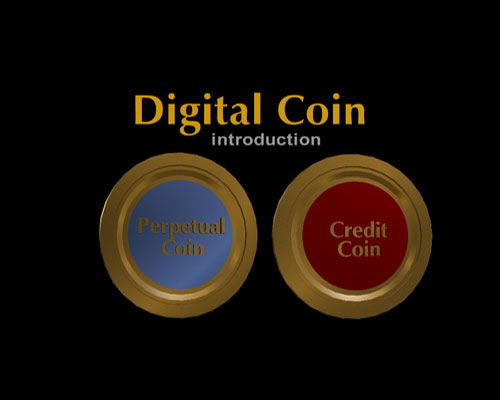
Solution page 4.0:
Digital Coin
home / contact
Digital Coin Introduction 8:31
This older movie uses Perpetual Coin as the Value Unit and Credit Coin is the Producer Credit.
While a few details have been changed in this proposal, the basic idea remains the same.
Digital Coin is proposed to be a digital “object” of value, like a $20 bill or a gold coin. It can be transferred electronically peer-to-peer like Bitcoin. But, unlike Bitcoin, it is not a speculative commodity that is inherently worthless. It is “a promise of something specific from someone specific”. By design, it is to be an inflation-proofed claim on the current and/or near-future production and/or services of its Issuer.
Paper cash is identified by serial numbers. The fancy paper and printing is to prevent duplication by counterfeiters. If it were possible to prevent duplication of serial numbers by other means, then the paper and fancy printing would no longer be necessary and we could transfer serial numbers digitally as "money objects".
Digital Coin is proposed to be a unique serial number that is immune to unauthorized alteration, because it cannot be found and accessed without the owner’s unique username, PIN and password. The Digital Coin software alone can find, read and alter this serial number.
Each serial number is a contract with the Bearer for redemption in products or services by a specific provider (the Issuer). Producer Credits can exist and be transferred anonymously peer-to-peer.
The serial number contains information and instructions that the Digital Coin software can
act upon. The first section of the serial number identifies the Issuer of the Producer Credit.
1. Because Producer Credits operate on the opt-in principle, the Issuer must be identified as acceptable to the receiver of the Credit YES? / proceed / NO try next credit.
2. The second identifies the specific contract that this Producer Credit represents and its maturity DATE. input current DATE / calculates % maturity / consults preferences / SPEND or SAVE? / YES? / proceed / NO return to 1, try next credit.
3. The third section identifies the current owner of the Producer Credit. No one but the owner can spend a Producer Credit. Therefore, the Credit does not actually need to be “sent” anywhere. The ownership section is rewritten by the software so that only the new owner can access it.
4. The fourth section identifies the denomination in the system's inflation-proofed value unit. Producer Credit can be combined to many multiples and decimal places. A whole Producer Credit would have a denomination of 0000001.0000000 value units
During a transaction, in order to make “exact change”, this Producer Credit might be subdivided into two. Fragment 1 might have its denomination changed to …0.020000 leaving fragment 2 with a denomination of …0.980000.
If fragment 2 is further subdivided into …0.700000 and …0.280000, the original Producer Credit will have become three Producer Credits.
Let us say the Issuer’s identifier is ABCDE and the contract is 010109…7456. Then the three
fragments would have serial numbers as follows.
Fragment 1 ABCDE: 010109…74756: OWNER1: 0000000.0200000
Fragment 2 ABCDE: 010109…74756: OWNER2: 0000000.7000000
Fragment 3 ABCDE: 010109…74756: OWNER3: 0000000.2800000
If any of these fragments, or other fragments of the same contract come together later under the same ownership, the software will recombine them, and the resultant larger Producer Credit will be appropriately re-denominated.
Combination of two fragments from above:
Fragment 1 ABCDE: 010109…74756: OWNER1: 0000000.0200000
Fragment 3 ABCDE: 010109…74756: OWNER3: 0000000.2800000
Recombination 1 ABCDE: 010109…74756: OWNER4: 0000000.3000000
Other fragments added:
Add ABCDE: 010109…74756: OWNER4: 0000010.4300000
Combined Credit ABCDE: 010109…74756: OWNER4: 0000010.7300000
5. For the purpose of evaluating the relative market value of this Producer Credit while processing a transaction, the Digital Coin software must access the online Producer Credit marketplace to ascertain the current buy/sell ratio (a moving average) for this Producer Credit. The denomination is then multiplied by this ratio to get the transaction value in value units. All prices are expressed in inflation-proofed value units.
Check buy/sell ratio for ABCDE. Example ratio returned is 1.010
At this moment, ONE ABCDE Credit is worth 1.01value unit. Other Producer Credits involved
would return different values for their real-time buy/sell ratio and produce appropriately
redenominated system values. 10.73 ABCDE CC x 1.01 (buy/sell) = 10.8373 value units.
Thus, by means of a serial number and very simple arithmetic carried out at light speed, Digital Coin technology can be used to create an extremely fluid and responsive exchange system, one that self–corrects all participants back towards perfect balance of trade by an automated revaluing of credit issues according to proven demand in real time.
